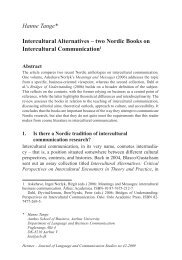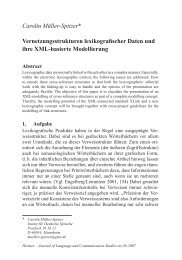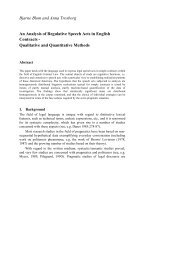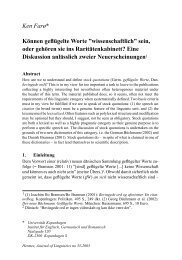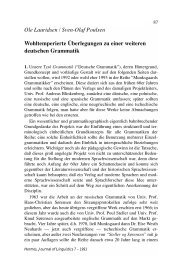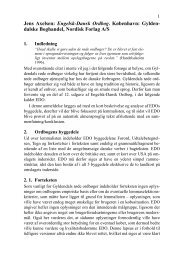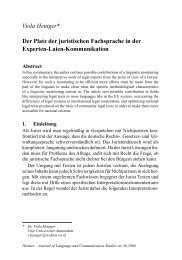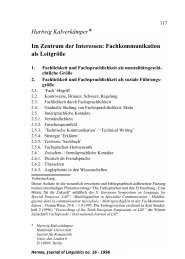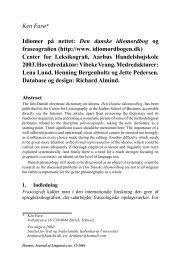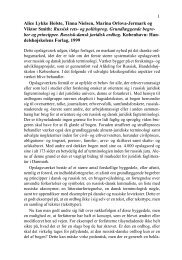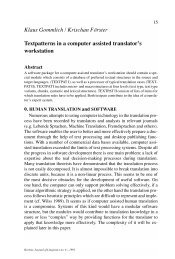Hermes-41-8-tange - Hermes - Journal of Linguistics
Hermes-41-8-tange - Hermes - Journal of Linguistics
Hermes-41-8-tange - Hermes - Journal of Linguistics
Create successful ePaper yourself
Turn your PDF publications into a flip-book with our unique Google optimized e-Paper software.
155<br />
Hanne Tange*<br />
Global Commitment or Local Grievances?<br />
An Assessment <strong>of</strong> the Grundfos Language Policy<br />
Abstract<br />
This empirical study discusses language workers’ involvement with and responses to<br />
the introduction <strong>of</strong> a corporate language policy at the Danish multinational Grundfos in<br />
April 2004. The core argument is that a discrepancy exists between language workers’<br />
global commitment to language management and respondents’ local practices. The<br />
analysis explores this differentiation in relation to the themes <strong>of</strong> language value,<br />
language visibility, and the visibility <strong>of</strong> the corporate language policy, comparing<br />
the conflicting views <strong>of</strong> respondents from management, communications, branding,<br />
technical marketing, production, and development units. This leads to the conclusion<br />
that the effect <strong>of</strong> the corporate language initiative is closely related to language attitudes<br />
in the different parts <strong>of</strong> the organisation, which calls for a research perspective that may<br />
accommodate local as well as global concerns.<br />
1. Introduction<br />
Recent research on language management has underlined the connection<br />
between economic globalisation and multinational corporations’<br />
adoption <strong>of</strong> a corporate policy on language, addressing the question <strong>of</strong><br />
multilingualism from a strategic perspective (e.g. Marschan-Piekkari<br />
et al. 1999a, 1999b, Dhir 2005, Feely/Harzing 2003). The present examination<br />
adopts an alternative approach to corporate language, emphasising<br />
the social meaning <strong>of</strong> organisational policy-making and communication<br />
for individual actors’ experiences with and attitudes to the<br />
implementation <strong>of</strong> a language policy. Drawing on a series <strong>of</strong> qualitative<br />
research interviews performed with language workers at the Danish<br />
headquarters <strong>of</strong> the multinational Grundfos, the analysis seeks to dem-<br />
* Hanne Tange<br />
Aarhus School <strong>of</strong> Business, University <strong>of</strong> Aarhus<br />
Department <strong>of</strong> Language and Business Communication<br />
Fuglesangs Allé 4<br />
DK-8210 Aarhus V<br />
hta@asb.dk<br />
<strong>Hermes</strong> – <strong>Journal</strong> <strong>of</strong> Language and Communication Studies no <strong>41</strong>-2008
156<br />
onstrate that a discrepancy exists between respondents’ general commitment<br />
to the corporate language policy and their assessment <strong>of</strong> the<br />
relevance <strong>of</strong> this initiative to their everyday routines and relationships.<br />
In the present inquiry, the notions <strong>of</strong> “global” and “local” are used with<br />
reference to organisational geography. Accordingly, “global” characterises<br />
units or policies that relate to the multinational as a whole (e. g.<br />
CEO strategies, the corporate branding manual and central units such<br />
communications, branding and technical marketing), whereas “local”<br />
describes units or policies operating at the microlevel <strong>of</strong> organisation.<br />
The investigation was prompted by Grundfos’ publication <strong>of</strong> a corporate<br />
language policy, In other words ..., in March 2004. This document<br />
was authored by a team <strong>of</strong> language and communication workers,<br />
the so-called Language Group, and targeted, as the introduction<br />
states, at “all Grundfos employees who write English regularly or <strong>of</strong>ten”<br />
(Grundfos 2004: 1). Hence, In other words ... addresses all English<br />
users within the multinational, reflecting a corporate reality in which<br />
the writing <strong>of</strong> English letters, reports and product specifications was<br />
no longer the prerogative <strong>of</strong> specially trained language staff. Twelve<br />
months later, in March 2005, I contacted the company in order to conduct<br />
a study on the process <strong>of</strong> developing and implementing a corporate<br />
strategy on language.<br />
As the focal point <strong>of</strong> my inquiry, I chose the group <strong>of</strong> language workers<br />
because <strong>of</strong> the importance <strong>of</strong> language to the work functions and<br />
routines <strong>of</strong> these employees. I assumed that language workers would be<br />
particularly sensitive to the effects <strong>of</strong> a corporate language policy and<br />
therefore among the first employees to notice a change in language attitudes<br />
and quality. For the purpose <strong>of</strong> the present study, I define a language<br />
worker as an employee who has an educational qualification in<br />
language (LSP or modern languages) and/or an employee whose work<br />
duties include language activities such as technical writing, translation,<br />
or pro<strong>of</strong> reading.<br />
The interviews with the language workers uncovered a number <strong>of</strong><br />
disagreements about the corporate language policy, highlighting a lack<br />
<strong>of</strong> consensus within the group. At the organisational level, a conflict <strong>of</strong><br />
interests emerged between respondents located in different units, with<br />
language workers from the areas <strong>of</strong> communications, branding and<br />
management voicing their enthusiasm about the initiative, whereas rep-
157<br />
resentatives from production and development groups were more sceptical.<br />
At the individual level, the opinions expressed by single actors<br />
were sometimes self-contradictory, shifting between a general commitment<br />
to linguistic quality and the pragmatic acceptance <strong>of</strong> language as<br />
a secondary concern in an engineering culture. The current examination<br />
aims to explain such differences, applying an approach to language<br />
that takes into consideration language workers’ local as well as global<br />
concerns.<br />
The article begins with a theoretical section, which reviews previous<br />
literature on the subject <strong>of</strong> corporate language which has contributed to<br />
the conceptual framework <strong>of</strong> the present discussion. This is followed by<br />
a section on research methodology and the company, which also outlines<br />
aspects <strong>of</strong> the Grundfos language initiative that are <strong>of</strong> special relevance<br />
to the present inquiry. The analysis discusses the global-local<br />
theme in relation to language value, language visibility and language<br />
policy, which leads to a final reflection on the social meaning <strong>of</strong> corporate<br />
language.<br />
2. Literature review<br />
Within the field <strong>of</strong> corporate language research one may distinguish between<br />
a linguistic (e.g. Bergenholtz et al. 2003, Nickerson 2000), a strategic<br />
(e.g. Feely/Harzing 2003, Dhir 2005), a “business lingua franca”<br />
(Louhiala-Salminen 2003, Charles 2007), and a practice-oriented perspective<br />
(e.g. Marschan-Piekkari et al. 1999a, 1999b, Park et al. 1996).<br />
The present argument builds on this previous research, seeking to combine<br />
the more theoretical perspectives on the linguistic and/or strategic<br />
value <strong>of</strong> corporate language with empirical, practice-oriented studies <strong>of</strong><br />
language as a social practice (Bourdieu 1991, 1993). In the literature,<br />
these two ways <strong>of</strong> looking at corporate language have inspired very<br />
different interpretations <strong>of</strong> the effect that an act <strong>of</strong> language management<br />
has on linguistic behaviour within multinationals. Yet the Grundfos<br />
data indicate that both attitudes are part <strong>of</strong> respondents’ social experience,<br />
which has prompted the current attempt to bring them together.<br />
The strategic approach to corporate language <strong>of</strong>ten relies on a mechanical<br />
perception <strong>of</strong> language which suggests that communication be<br />
measured in terms <strong>of</strong> its speed, efficiency and accuracy (Jannsens et al.<br />
2004). Research seeks to identify the obstacles that multilingualism cre-
158<br />
ates for cross-cultural communication, coordination and management,<br />
presenting language policy-making as a strategic solution to problems<br />
arising from linguistic diversity (e.g. Feely/Harzing 2003, Dhir/Gòkè-<br />
Paríolá 2002). The literature on corporate language names a number <strong>of</strong><br />
organisational activities affected by language differences. They include<br />
company-customer relations (Czerniawska 1997), information flow and<br />
knowledge sharing (Dhir/Savage 2002), external and internal communication<br />
(Feely/Harzing 2003), employees’ sense <strong>of</strong> corporate membership,<br />
and their ability to overcome linguistic and/or cultural distances<br />
within the corporation (Dhir/Gòkè-Paríolá 2002). Because <strong>of</strong> the potential<br />
disruption caused by multilingualism, it is recommended that multinationals<br />
pursue a policy <strong>of</strong> monolingualism:<br />
Having a monolingual corporate environment means that we share the<br />
same fundamental preconceptions about the world: whatever our individual<br />
differences, we have a common outlook. This engenders a<br />
sense <strong>of</strong> trust – we only need to think <strong>of</strong> how uncomfortable we can<br />
feel when two people in front <strong>of</strong> us converse in a language we do not<br />
understand to see how true this is. It also promotes a sense <strong>of</strong> equality.<br />
While we may not all have access to the same information, sharing a<br />
common language means that in theory we could access it. (Czerniawska<br />
1997: 126)<br />
The rhetoric <strong>of</strong> language management resembles the strategic discourse<br />
surrounding corporate change initiatives (e.g. Finnie/Norris 1997).<br />
Against this background, one may conclude that a consensus exists between<br />
management theorists and corporate planners with regard to the<br />
relevance <strong>of</strong> a language policy to international companies. In relation to<br />
the implementation process, management theorists tend to regard corporate<br />
language as a strategic decision to be taken at the top <strong>of</strong> the multinational,<br />
which means that they focus their attention on the macro<br />
level <strong>of</strong> organisation. As a result, the research outlines the reasons why<br />
corporations should adopt a common medium, but contains only little<br />
information on what a language policy might include and how it is<br />
transformed from an ideological commitment into linguistic practice.<br />
For a pragmatic insight into the workings <strong>of</strong> existing language policies<br />
on cross-cultural communication, one will have to consult empirical,<br />
practice-oriented studies <strong>of</strong> corporate language. This type <strong>of</strong> inquiry<br />
is less concerned with the management arguments behind the adoption<br />
<strong>of</strong> a corporate language, focusing instead on the impact that stra-
159<br />
tegic moves towards language standardisation have on organisational<br />
members’ communicative competence, job performance and satisfaction.<br />
Unlike the strategic approach, which primarily discusses monolingualism<br />
as a theoretical option, a practice-oriented perspective involves<br />
a case study <strong>of</strong> linguistic behaviours and attitudes, which allows<br />
researchers to draw a picture <strong>of</strong> corporate language usage grounded<br />
in actors’ social practice. The most significant example is Marschan-<br />
Piekkari et al.’s examination <strong>of</strong> the Finnish multinational Kone, which<br />
shows how the introduction <strong>of</strong> English as a corporate medium does not<br />
necessarily remove existing language barriers, but may indeed cause alternative<br />
power structures to emerge within the organisation (Marschan<br />
et al. 1997, Marschan-Piekkari et al.1999b). In other words, the Kone<br />
investigation suggests that corporate language may have added to cultural<br />
and linguistic distances within this particular company because<br />
certain members lack the fluency required to perform their everyday<br />
routines in English. In comparison, employees with strong language<br />
skills occupy a powerful position as language nodes, (i.e. facilitators <strong>of</strong><br />
communication between the Finnish HQ and any non-Finnish subsidiary),<br />
which enables them to obtain a disproportionate amount <strong>of</strong> influence<br />
and privileges (Marschan-Piekkari et al. 1999a, Welch et al. 2005).<br />
Park et al. report a similar result with regard to language usage by Korean<br />
managers in American-owned subsidiaries in South Korea (1996).<br />
The core argument is that American managers’ choice <strong>of</strong> English as the<br />
preferred executive medium creates an asymmetrical communication<br />
situation, which privileges local managers with strong language skills<br />
at the expense <strong>of</strong> those who lack fluency in the corporate language. In<br />
short, practice-oriented research into corporate language has demonstrated<br />
how language barriers prevail in spite <strong>of</strong> attempted homogenisation,<br />
explaining this persistence with reference to individual actors’<br />
language skills as well as their physical location within the local and<br />
global organisation.<br />
The current paper seeks to bring together the strategic and practiceoriented<br />
approaches, emphasising that a common medium has symbolic<br />
as well as practical value to the language workers. On the one hand,<br />
respondents are inspired by the management rhetoric on corporate language,<br />
which comes across as a support for a change initiative aiming to<br />
improve the standards <strong>of</strong> written and spoken English across the multinational.<br />
Accordingly, they use personal anecdotes about miscommuni-
160<br />
cation to stress the relevance <strong>of</strong> linguistic quality to organisational communication<br />
and coordination. On the other hand, the interviews reveal a<br />
lack <strong>of</strong> consensus with regard to the actual impact <strong>of</strong> the corporate policy<br />
on individual language workers’ everyday experiences and relationships.<br />
While some claim to have witnessed a growing demand for language<br />
services such as pro<strong>of</strong> reading since the launch <strong>of</strong> In other words<br />
... , others state that the corporate guidelines have made little difference,<br />
and this has prompted them to shelve the language policy. The analysis<br />
will bring out this dual orientation, underlining how respondents may<br />
be caught in a constant wavering between a general commitment to and<br />
a local scepticism about the act <strong>of</strong> language policy-making.<br />
To recapitulate, the discussion has examined the strategic and practice-oriented<br />
perspectives on corporate language in order to propose<br />
an analytical framework that brings the two together. This provides the<br />
conceptual foundation for the analysis, <strong>of</strong>fering a possible explanation<br />
for the discrepancies encountered in the interviews. Prior to this, however,<br />
I should like to provide more information on the company, the<br />
corporate language initiative, as well as my research methodology and<br />
data collection.<br />
3. Data and methodology<br />
The current section consists <strong>of</strong> three parts. Part one and two contain a<br />
company pr<strong>of</strong>ile and a presentation <strong>of</strong> the corporate language initiative.<br />
Part three provides information on research methodology, as well as the<br />
process <strong>of</strong> data collection.<br />
3.1. Company pr<strong>of</strong>ile<br />
With a workforce <strong>of</strong> around 11 000 and companies in 43 countries,<br />
Grundfos represents a major player in the Danish economy. The main<br />
production area is pumps, and a large proportion <strong>of</strong> the employees are<br />
engineers or other technical staff. The corporate headquarters is located<br />
in Bjerringbro, which is a small town (pop. 3 000) in the western part<br />
<strong>of</strong> the country. Although Grundfos actively pursues a policy <strong>of</strong> diversity<br />
with regard to gender, ethnicity, ability and nationality, the majority<br />
<strong>of</strong> the employees at the Bjerringbro site are Danish-speaking. This<br />
means that the national language can be used as the primary means <strong>of</strong><br />
communication at the lower levels <strong>of</strong> organisation, and that many <strong>of</strong> the
161<br />
respondents’ routine interactions are performed in Danish rather than<br />
English.<br />
3.2. The language initiative<br />
In its mission statement, the CEO emphasises a corporate commitment<br />
to employee involvement, decentralisation and value-based management,<br />
which reflects on the language policy. The Grundfos language<br />
policy was thus initiated by language workers from the organisational<br />
units <strong>of</strong> communications, branding, corporate management, and technical<br />
marketing. With the rise <strong>of</strong> new media such as e-mail and the internet,<br />
they had seen an increase in the number <strong>of</strong> non-pr<strong>of</strong>essional language<br />
users involved in communication activities (e. g. engineers, line<br />
managers and marketers), and feared that the quality <strong>of</strong> language might<br />
deteriorate as a consequence there<strong>of</strong>. In response, they formed the Language<br />
Group, which in 2003 published the Danish language policy Med<br />
andre ord ... in an attempt to highlight to their colleagues the value <strong>of</strong><br />
good language. The CEO responded to the initiative by requesting a<br />
similar guide to English, which functions as the <strong>of</strong>ficial corporate medium<br />
for communication activities involving individuals or units from<br />
more than one country. Such recognition by the corporate management<br />
was important to the project as it resulted in an allocation <strong>of</strong> resources<br />
to the Language Group, while sending out the signal to all employees<br />
that the CEO regarded language as a significant part <strong>of</strong> the company<br />
image.<br />
The motivation behind the Grundfos language policy may be characterised<br />
in linguistic, pragmatic, or strategic terms. With regard to language,<br />
the members <strong>of</strong> the Language Group first met on the assumption<br />
that something needed to be done to improve the standards <strong>of</strong> written<br />
communication within the organisation. Their aim was to change the attitude<br />
to language within the multinational, inviting non-specialists to<br />
use the services <strong>of</strong> trained language staff as pro<strong>of</strong> readers or coaches.<br />
In comparison, language workers outside the Language Group tended<br />
to regard the language policy as an answer to pragmatic questions. The<br />
lack <strong>of</strong> a standardised corporate terminology meant that a single component<br />
had different names across the organisation, which caused misunderstandings<br />
in internal as well as external communication. A corporate<br />
language policy would resolve this issue, providing a common
162<br />
point <strong>of</strong> reference in linguistic matters. Finally, the corporate management<br />
may have supported the language initiative on strategic grounds<br />
(Dhir/Gòkè-Paríolá 2002: 246). By promoting the corporate language<br />
<strong>of</strong> English, the CEO sought to strengthen employees’ formal and informal<br />
networks, allowing for a more effective and rapid exchange <strong>of</strong> information<br />
within the multinational.<br />
A distinctive trait <strong>of</strong> the Grundfos language policy is the function <strong>of</strong><br />
language ambassador. In other words ... defines language ambassadors<br />
as:<br />
[Local] promoters <strong>of</strong> the Grundfos language guide. Language ambassadors<br />
may have a language background, but this is not a requirement;<br />
the best qualification is to have an active interest in promoting the<br />
good language as an important part <strong>of</strong> Grundfos’ image.” (Grundfos<br />
2004: 76)<br />
The image <strong>of</strong> language ambassadors introducing the corporate language<br />
guide to their respective units fits in neatly with the company principle<br />
<strong>of</strong> decentralisation. Accordingly, the Language Group made use <strong>of</strong> existing<br />
informal and formal networks in their attempt to change members’<br />
linguistic practice, which is interesting in the light <strong>of</strong> language<br />
management theory, which suggests a top-down process <strong>of</strong> implementation.<br />
Yet the interviews indicate that the language ambassadors may<br />
be at the heart <strong>of</strong> the global-local divide over corporate language. By<br />
relying on this group <strong>of</strong> intermediaries to spread the corporate policy,<br />
the Language Group appear to have compromised their global message,<br />
exposing the change initiative to the disruptive influences <strong>of</strong> local discontent<br />
and micro geography.<br />
3.3. Research methodology<br />
The Grundfos interviews present a picture <strong>of</strong> language workers’ attitudes<br />
to the corporate language twelve months after the publication <strong>of</strong><br />
a written language handbook. In the interviews respondents were asked<br />
to assess the effect <strong>of</strong> the language initiative on their respective parts<br />
<strong>of</strong> the organisation, indicating to what extent they found that a written<br />
document on language had made a difference to their routines and relationships.<br />
The responses highlight the diversity with regard to language<br />
attitudes across the organisation. Hence, the analysis <strong>of</strong> the data<br />
underlines differences as well as similarities among the language work-
163<br />
ers, revealing a gap between an ideological pledge to language quality<br />
and a practical ability to translate this engagement into a working social<br />
practice.<br />
The choice <strong>of</strong> Bjerringbro as the locus for the research was prompted<br />
by the fact that this is the principal Danish site, which in addition to<br />
the corporate headquarters hosts a range <strong>of</strong> administrative, marketing,<br />
production, and development functions. At the Bjerringbro site, it was<br />
therefore possible to obtain an adequate distribution in terms <strong>of</strong> organisational<br />
activities (e.g. management, communications, production &<br />
development) and specific language worker functions (e.g. secretary,<br />
technical writer, communication worker). The selection <strong>of</strong> respondents<br />
was made with the assistance <strong>of</strong> organisational gatekeepers in the<br />
Grundfos Language Group, who helped identify language workers interested<br />
in partaking in this type <strong>of</strong> investigation. During the interview<br />
stage, a total <strong>of</strong> eleven in-depth interviews were carried out, each lasting<br />
between forty and sixty minutes. I have since revisited the company<br />
in order to verify my findings with key actors in the process.<br />
The respondents were all Danish, which meant that interviews were<br />
conducted in the respondents’ native language rather than English. With<br />
one exception, they were women, which may influence the way they<br />
experience social interaction with the engineers, who are mostly male.<br />
Ten respondents had an educational background in modern languages,<br />
while the eleventh had become involved in language activities because<br />
<strong>of</strong> a personal interest in language quality. In terms <strong>of</strong> organisational<br />
activities, the respondents represented the units <strong>of</strong> corporate management<br />
(one), communications (one), branding (two), technical marketing<br />
(two), and production & development (five). With regard to organisational<br />
functions, the sample counted two communication workers,<br />
one pro<strong>of</strong> reader, two technical writers, and six secretaries and/or personal<br />
assistants.<br />
The data collection was designed according to Kvale’s seven-stage<br />
model for qualitative research interviews (1997: 95). The theme <strong>of</strong> the<br />
inquiry was developed in co-operation with the members <strong>of</strong> the Language<br />
Group, taking into consideration the interests <strong>of</strong> the company as<br />
well as the researcher. The interview guide was composed <strong>of</strong> open-ended<br />
questions structured around four central themes: respondent’s work<br />
functions, communication within the organisation, language attitudes,
164<br />
and language policy. The inquiry was exploratory in nature, seeking to<br />
pursue the topics that respondents raised in the course <strong>of</strong> our conversations.<br />
Accordingly, initial data processing was carried out simultaneously<br />
with the collection <strong>of</strong> information, which allowed for a continuous<br />
integration <strong>of</strong> emergent themes into the interview guide (Spradley<br />
1979). The analysis relied on taxonomy trees, which organise respondent<br />
statements thematically (Spradley 1979, Gregory 1983). This highlighted<br />
the importance <strong>of</strong> the global/local dichotomy, which was consequently<br />
identified as the core theme <strong>of</strong> the discussion.<br />
The choice <strong>of</strong> a qualitative research method has certain limitations.<br />
First, the examination builds on a relatively small sample, which means<br />
that the experiences conveyed in the interviews cannot be regarded as<br />
representative <strong>of</strong> all language workers at Grundfos. Against that background,<br />
it is important that the experiences conveyed in the analysis be<br />
read as personal statements and not as an objective account <strong>of</strong> language<br />
usage and attitudes across the global organisation. Second, the focus on<br />
a single Danish site means that the findings do not necessarily apply to<br />
the communicative situation in Grundfos companies outside Denmark.<br />
To make a cross-cultural study, new research is requested, involving the<br />
performance <strong>of</strong> interviews with international language workers representing<br />
functions similar to the Danes’. In spite <strong>of</strong> such weaknesses, the<br />
employment <strong>of</strong> a qualitative method contributes to the understanding<br />
<strong>of</strong> corporate language as a social practice. While quantitative research<br />
tools mainly cater for macrolevel analysis and cross-cultural comparison,<br />
a qualitative approach allows for contextualised inquiries on individual<br />
actors’ social practice and relationships. Hence, qualitative research<br />
interviews are oriented towards the micro level <strong>of</strong> organisation,<br />
which is my motivation for adopting this as the principal technique <strong>of</strong><br />
the present study.<br />
4. Analysis <strong>of</strong> the Grundfos data<br />
For reasons <strong>of</strong> clarity, the analysis has been divided into sections on the<br />
value <strong>of</strong> language, the visibility <strong>of</strong> language activities, and the visibility<br />
<strong>of</strong> the corporate language policy. Within each part, examples <strong>of</strong> global<br />
and local viewpoints are examined in an attempt to underline the divided<br />
loyalties <strong>of</strong> the Grundfos language workers.
165<br />
4.1. The value <strong>of</strong> language<br />
A central issue in relation to corporate language is the value <strong>of</strong> a common<br />
medium. Unlike labour and production costs, linguistic worth is<br />
hard to measure in economic terms, which explains why it has been<br />
named the “forgotten” aspect <strong>of</strong> multinational management (Marschan<br />
et al. 1997). In an attempt to resolve the matter, Dhir (2005: 371) compares<br />
an economist/decision analyst perception <strong>of</strong> language as a means<br />
to “maximize the organization’s competitive advantage” to the sociolinguistic<br />
mission to “maximize the quality and the quantity <strong>of</strong> the social<br />
interactions”, arguing for a possible resemblance <strong>of</strong> language to<br />
currency. Yet the majority <strong>of</strong> the literature on corporate language ignores<br />
the value question, which is understandable given the problems<br />
that it raises.<br />
The Grundfos data <strong>of</strong>fer an insight into how employees assess the<br />
value <strong>of</strong> language. First <strong>of</strong> all, language workers distinguish between<br />
linguistic (high standards <strong>of</strong> written and/or oral language) and economic<br />
value (pr<strong>of</strong>itability). With regard to the former, there appears to be a<br />
consensus that language quality needs to be acknowledged as an asset<br />
to the multinational, and that poor linguistic standards reflect badly on<br />
the corporate brand. As one respondent puts it:<br />
I think [language] is important. Very important. This has something to<br />
do with our external image ... . If I spot fifteen spelling errors in a leaflet,<br />
then I cannot believe that these people are capable <strong>of</strong> manufacturing<br />
a quality product. (pro<strong>of</strong> reader, branding).<br />
At the same time, language workers have to accept that they represent a<br />
minority within the organisation, and that not all colleagues share their<br />
linguistic concerns:<br />
Language is not very important in a company where most employees<br />
are engineers, and [engineering activities] are what we make our money<br />
from. It is a way <strong>of</strong> talking to your colleagues and you will encounter<br />
people writing e-mails, etc. – you’d be surprised to see what is sent<br />
out, the kinds <strong>of</strong> errors and strange expressions, but this is <strong>of</strong> secondary<br />
importance. In situations when things get really busy, language is<br />
not conceived <strong>of</strong> as a priority. (technical writer, technical marketing)<br />
The contrast between language workers’ and engineers’ attitudes to linguistic<br />
value suggests a possible conflict <strong>of</strong> interests between the two<br />
pr<strong>of</strong>essional communities. Against that background, one might expect
166<br />
language workers to support an ideological commitment to corporate<br />
language, which will justify or indeed strengthen their position within<br />
the organisation.<br />
However, the interviews reveal divisions within the group <strong>of</strong> language<br />
workers. For when respondents are asked to assess linguistic<br />
value within the context <strong>of</strong> their immediate work environment, it becomes<br />
evident that language is perceived differently across the organisation.<br />
On the one hand, employees from the management, communications,<br />
and branding units express a strong, ideological commitment<br />
to language quality, stressing that they find linguistic worth to be recognised<br />
by their colleagues regardless <strong>of</strong> their pr<strong>of</strong>essional memberships.<br />
Accordingly, one respondent observes with reference to the corporate<br />
management:<br />
I sincerely believe that our chief executives are very capable <strong>of</strong> spotting<br />
the difference between something presented in good English and<br />
something presented badly. They know very well how important it is<br />
for us to have high linguistic standards. (secretary, management)<br />
On the other hand, respondents working in production and development<br />
units are less enthusiastic. Language ambassadors underline how time<br />
pressure, indifference, or indeed a lack <strong>of</strong> awareness prompt many nonpr<strong>of</strong>essional<br />
language users to ignore the CEO request for language<br />
quality, continuing in the same way as always. One member <strong>of</strong> the Language<br />
Group ascribes this tendency to local managers’ behaviour:<br />
Really, what I find to be the scariest thing is how a lack <strong>of</strong> acceptance<br />
spreads within the organisation. For if a local manager refuses to acknowledge<br />
[his/her linguistic weaknesses], then the rest <strong>of</strong> the group<br />
will typically follow [his/her] lead. So when the manager does not<br />
recognise that s/he might require linguistic support, then his/her subordinates<br />
will not see a need for assistance either. (secretary, management)<br />
In other words, different language attitudes seem to inspire divergent<br />
practices across the organisation, which underlines the gap between an<br />
overall commitment to language management and reality on the shop<br />
floor.
167<br />
4.2. The visibility <strong>of</strong> language activities<br />
The extent to which managers and members perceive language as a<br />
company asset is crucial to language visibility because it influences the<br />
amount <strong>of</strong> resources allocated to linguistic activities. Marschan-Piekkari<br />
et al. has identified language as the great unknown in multinational<br />
management, suggesting that international managers are not necessarily<br />
aware <strong>of</strong> language as a factor in global business (Marschan et al.<br />
1997, Marschan-Piekkari et al. 1999b). Frequently, managers will take<br />
for granted employees’ ability to cope in English, and a group <strong>of</strong> very<br />
dedicated language enthusiasts may be required to convince top managers<br />
<strong>of</strong> the need for a language policy. This is what happened in the<br />
Grundfos example where the Language Group had to demonstrate the<br />
relevance <strong>of</strong> their work through the publication <strong>of</strong> a Danish handbook<br />
before the corporate management decided to invest in a written language<br />
policy. For individual language workers, the visibility <strong>of</strong> language<br />
tasks influences the amount <strong>of</strong> recognition received from local<br />
managers and colleagues. In relation to this, one may distinguish between<br />
respondents performing very visible language tasks and respondents<br />
whose language work is more implicit.<br />
Language workers who enjoy a high degree <strong>of</strong> visibility, include respondents<br />
representing the corporate activities <strong>of</strong> management, branding,<br />
communications, and technical marketing. Among their principal<br />
responsibilities are product specifications, PR materials, user instructions,<br />
and employee magazines, which are all very noticeable parts <strong>of</strong><br />
the company’s internal and external image. This motivates respondents<br />
to stress the explicit character <strong>of</strong> language within the multinational, describing<br />
work environments where the performance <strong>of</strong> oral and written<br />
communication constitutes a core activity. Central to these language<br />
workers’ experience is their colleagues’ acceptance <strong>of</strong> linguistic expertise<br />
as a competence equivalent to technical or management pr<strong>of</strong>iciencies.<br />
As one respondent observes, it is essential that cooperation across<br />
pr<strong>of</strong>essional boundaries builds on the strengths <strong>of</strong> each occupational<br />
community:<br />
As linguists, we will have to accept that the engineers have the technical<br />
knowledge and represent an expertise within that area. So when a<br />
team <strong>of</strong> experts have chosen a specific name for a component, we may<br />
have to accept this as the technical term even if our linguistic knowl-
168<br />
edge tells us that this is not quite right. (technical writer, technical<br />
marketing)<br />
However, individual members’ ability to negotiate a compromise between<br />
linguistic and technical demands depend on their organisational<br />
position. While language workers in visible functions have few difficulties<br />
raising the question <strong>of</strong> language quality with colleagues from other<br />
pr<strong>of</strong>essional communities, respondents from development and production<br />
groups have a different story to tell. As a secretary from a production<br />
unit explains:<br />
[One] thing that is frequently discussed is that engineers today – they<br />
can do anything. They use their computers when writing in English,<br />
and this is so easy. That the result may not always be worth their effort<br />
– well, that is something we focus on. We hear from the management<br />
how people should use the secretaries for pro<strong>of</strong> reading purposes and<br />
avoid sending out anything that has not been checked ... . Yet we very<br />
much leave it to the individual employee to decide whether something<br />
needs to be checked or it can be sent out as it is.<br />
The statement reveals a lack <strong>of</strong> concern with language in the respondent’s<br />
part <strong>of</strong> the multinational, implying that linguistic skills represent<br />
a hidden competence that is not acknowledged by local managers and<br />
colleagues. The interviews <strong>of</strong>fer three explanations for the apparent invisibility<br />
<strong>of</strong> language. First, respondents from this group have been employed<br />
to perform various secretarial duties, which means that language<br />
is not necessarily their main responsibility. Unlike the specialists from<br />
communications or technical marketing, they may have few opportunities<br />
to develop their pr<strong>of</strong>essional knowledge, which makes their expertise<br />
less visible. Second, respondents emphasise that resources for language<br />
activities are scarce in production and development. This may<br />
be due to the fact that communication is mostly internal, but language<br />
workers also point to time pressure and financial restraints. Finally, respondents<br />
complain about a lack <strong>of</strong> support from colleagues outside the<br />
group <strong>of</strong> language workers. They explain how the promotion <strong>of</strong> corporate<br />
language is mostly met with indifference within their local work<br />
environment, and this has prompted them to exchange a global view on<br />
language for a more pragmatic approach. As one secretary puts is: “If<br />
you read what we receive from the Japanese or the Italians, they will
169<br />
understand each other even if the writing is not correct. And you see,<br />
that is the main thing” (production).<br />
4.3. The visibility <strong>of</strong> the language policy<br />
From an ideological perspective, the Grundfos language initiative can<br />
be seen as an attempt to increase the visibility <strong>of</strong> language across the organisation.<br />
A member <strong>of</strong> the Language Group explains how the format<br />
<strong>of</strong> In Other Words ... was copied from the corporate branding handbook<br />
in order to signal that the two texts were part <strong>of</strong> the same campaign to<br />
heighten employees’ awareness <strong>of</strong> quality as part <strong>of</strong> the Grundfos image.<br />
The decision to publish a written language handbook is interesting<br />
because it adds to the symbolic value <strong>of</strong> the corporate language. Unlike<br />
the Kone case where the decision to use English was mainly strategic<br />
(Marschan-Piekkari et al. 1999b, Welch et al. 2001), the Grundfos language<br />
initiative involves a physical manifestation <strong>of</strong> the corporate language<br />
through the written language handbook and the appointment <strong>of</strong><br />
local ambassadors across the organisation. Against that background, the<br />
corporate policy and the language ambassadors may be perceived as<br />
equally important to the change process.<br />
With regard to the global impact <strong>of</strong> the language initiative, there is a<br />
general consensus among the respondents that the act <strong>of</strong> language management<br />
has been worth the effort in the sense that a written document<br />
on language quality has increased the visibility <strong>of</strong> linguistic issues within<br />
the multinational. The involvement <strong>of</strong> the corporate management in<br />
the launch <strong>of</strong> the language policy has added to the strength <strong>of</strong> project,<br />
sending out the message to all pr<strong>of</strong>essional communities that language<br />
should be regarded as a priority area. The Group President (Grundfos<br />
2004: 1) writes in his introduction to In Other Words ...:<br />
Grundfos’ state-<strong>of</strong>-the-art products, our processes and services as<br />
well as our striving towards world class in Business Excellence are<br />
the result <strong>of</strong> teamwork. Similarly, the best way we can achieve excellence<br />
in communication and writing is by working closely together, by<br />
strengthening cross-functional cooperation and by utilising each other’s<br />
competence in this field.<br />
Respondents interpret this gesture in different ways. While one pro<strong>of</strong><br />
reader sees the corporate policy as her justification for pursuing an active<br />
campaign against poor writing, other language ambassadors adopt
170<br />
a passive stance, expecting colleagues to approach them if requiring<br />
language assistance. Yet they agree that In Other Words ... is a nice tool<br />
for non-pr<strong>of</strong>essional language users, neatly presented and very accessible,<br />
which is intriguing in the light <strong>of</strong> the following comment by one<br />
<strong>of</strong> the authors: “this is no reference book. It is more about attitudes. We<br />
have probably regarded it as a tool for the ambassadors who would then<br />
influence their colleagues” (communication worker, communications).<br />
Language ambassadors’ conflicting views on their role in the change<br />
process have implications for the way they assess the effect <strong>of</strong> the language<br />
initiative on the local level <strong>of</strong> organisation. Respondents who<br />
have chosen a proactive stance tend to overestimate the impact <strong>of</strong> the<br />
language project, stressing that more language work is now performed,<br />
whereas respondents opting for a detached position, hardly seem to<br />
have observed a change. As one language ambassador puts it:<br />
I think this has made a difference to the language ambassadors. I think<br />
we have become more aware <strong>of</strong> these matters. But no – I do not think<br />
this has made any difference to our engineers or technicians. We had a<br />
launch <strong>of</strong> the language handbook, and that was it. It was handed out to<br />
those who wanted it. I do not think I have ever seen anyone consult the<br />
language handbook from where I am sitting. (secretary, production)<br />
Language workers’ evaluation <strong>of</strong> the language policy provides an interesting<br />
perspective on the global-local dichotomy in the sense that it<br />
consolidates the divisions identified in the previous parts <strong>of</strong> the analysis.<br />
Accordingly, respondents who are sceptical about the local effects<br />
<strong>of</strong> the language initiative, predominantly represent the functions <strong>of</strong> production<br />
and development, while the enthusiasts come from communications,<br />
branding, and technical marketing. This suggests that the split<br />
within the group <strong>of</strong> language workers lies very deep, and that the present<br />
investigation <strong>of</strong> corporate language may have served as a mere outlet<br />
for grievances motivated by other circumstances. However, a substantiation<br />
<strong>of</strong> this point will require more research on the community <strong>of</strong> language<br />
workers, which is beyond the scope <strong>of</strong> the present discussion.<br />
5. Conclusion<br />
The current inquiry has highlighted the polyvocality <strong>of</strong> organisational<br />
experiences (Bate 1997: 1166), underlining the different perceptions <strong>of</strong><br />
a corporate language initiative that one may encounter within the group
171<br />
<strong>of</strong> language workers at the Danish multinational Grundfos. Drawing on<br />
a series <strong>of</strong> qualitative research interviews, the analysis has examined<br />
the core themes <strong>of</strong> language value, language visibility, and the visibility<br />
<strong>of</strong> the corporate policy, highlighting to what extent respondents’ different<br />
language activities and work contexts explain their assessment <strong>of</strong><br />
and attitude to a corporate language initiative. This leads to the identification<br />
<strong>of</strong> a gap within the group <strong>of</strong> language workers, underlining the<br />
contrast between the global orientation <strong>of</strong> respondents from communications,<br />
branding, management, and technical marketing and the local<br />
views voiced by language workers in production and development<br />
units.<br />
The investigation has added to the existing knowledge on corporate<br />
language through its application <strong>of</strong> a research perspective capable <strong>of</strong><br />
presenting global and local perceptions <strong>of</strong> corporate language as complementary<br />
rather than mutually exclusive. Accordingly, the analysis<br />
relies on a strategic perspective to explain the motivation behind<br />
and development <strong>of</strong> the Grundfos language policy, whereas a practiceoriented<br />
approach is used to account for respondents’ responses to the<br />
change initiative. The advantage is that this allows for a comprehensive<br />
view on the act <strong>of</strong> corporate policy-making. While an understanding <strong>of</strong><br />
the development stage <strong>of</strong> language planning demands a concern with<br />
the ideological arguments behind language management, the later phases<br />
<strong>of</strong> implementation and dissemination relate closely to the respondents’<br />
practice, requesting a locally oriented approach. In consequence,<br />
a dual orientation is a significant part <strong>of</strong> the language workers’ experiences,<br />
which is why theories on corporate language will need to incorporate<br />
local as well as global viewpoints.<br />
The Grundfos research has two main implications for the practice<br />
<strong>of</strong> language management. First <strong>of</strong> all, it consolidates the findings <strong>of</strong><br />
Marschan-Piekkari et al.’s Kone study, challenging the common misconception<br />
that the adoption <strong>of</strong> a corporate policy on language inevitably<br />
eases knowledge-sharing and information flows within the multinational.<br />
The interviews show how the same language initiative is<br />
perceived very differently across the organisation, which suggests to<br />
managers that they take organisational diversity into consideration<br />
when planning a corporate policy. The second theme relates more specifically<br />
to the language workers. For, indirectly, respondents’ conflicting<br />
statements reveal the differentiation within the pr<strong>of</strong>essional com-
172<br />
munity, causing some members to disengage themselves from a project<br />
that they perceive to have little relevance to their everyday routines. In<br />
the analysis, language visibility and value are discussed as possible reasons<br />
for this behaviour, which indicates that the corporate language policy<br />
might have spread more evenly across the multinational, had these<br />
factors been addressed at the beginning <strong>of</strong> the process. To conclude, the<br />
Grundfos example demonstrates the importance <strong>of</strong> involving language<br />
workers throughout the process <strong>of</strong> developing and implementing a corporate<br />
policy, accepting their local grievances as a pragmatic antidote<br />
to language planners’ global commitment.<br />
Bibliography<br />
Bate, S. P. 1997: Whatever Happened to Organizational Anthropology? A Review <strong>of</strong><br />
the Field <strong>of</strong> Organizational Ethnography and Anthropological Studies. In Human<br />
Relations 50, 9, 1147-1175.<br />
Bergenholtz, Henning/Bisgaard, Jonna/Lauritsen, Majken Brunsborg/Wichman, Kamilla<br />
Kvist 2003: Sprogpolitik: So ein Ding müssen wir auch haben. In <strong>Hermes</strong> 31,<br />
135-165.<br />
Bourdieu, Pierre 1993: The Field <strong>of</strong> Cultural Production. Cambridge: Polity Press.<br />
Bourdieu, Pierre 1991: Language and Symbolic Power. Cambridge: Polity Press.<br />
Charles, Mirjaliisa 2007: Language Matters in Global Communication. In <strong>Journal</strong> <strong>of</strong><br />
Business Communication 44, 3, 260-282.<br />
Czerniawska, Fiona 1997: Corporate-Speak: The Use <strong>of</strong> Language in Business. Houndmills<br />
and London: MacMillan Business.<br />
Dhir, Krishna S. 2005: The value <strong>of</strong> language: concept, perspectives, and policies. In<br />
Corporate Communications: An International <strong>Journal</strong> 10, 4, 358-382.<br />
Dhir, Krishna S./Gòkè-Paríolá, Abíódún 2002: The case for language policies in multinational<br />
corporations. In Corporate Communications: An International <strong>Journal</strong> 7,<br />
4, 2<strong>41</strong>-251.<br />
Dhir, Krishna S./Savage, Theresa 2002: The value <strong>of</strong> a working language. In International<br />
<strong>Journal</strong> <strong>of</strong> the Sociology <strong>of</strong> Language 158, 1-35.<br />
Feely, Alan J./Harzing, Anne-Wil 2003: Language Management in Multinational Companies.<br />
In Cross Cultural Management 10, 2, 37-52.<br />
Finnie, Bill/Norris, Marilyn 1997: “Leading change: a conversation with John P. Kotter”.<br />
In Strategy and Leadership, Jan./Feb., 19-23.<br />
Gregory, K. L. 1983: Native-View Paradigms: Multiple Cultures and Culture Conflicts<br />
in Organizations. In Administrative Science Quarterly, 28, 359-376.
173<br />
Jannssens, Maddy/Lambert, José/Steyaert, Chris 2004: Developing language strategies<br />
for international companies: the contribution <strong>of</strong> translation studies. In <strong>Journal</strong> <strong>of</strong><br />
World Business 39, <strong>41</strong>4-430.<br />
Kvale, Steinar 1997: InterView: En introduktion til det kvalitative forskningsinterview.<br />
København: Hans Reitzels Forlag.<br />
Louhiala-Salminen, L. 2003: The fly’s perspective: discourse in the daily routine <strong>of</strong> a<br />
business manager. In English for Specific Purposes 21, 211-231.<br />
Marschan, Rebecca/Welch, Denice/Welch, Lawrence 1997: Language: The Forgotten<br />
Factor in Multinational Management. In European Management <strong>Journal</strong> 15, 5,<br />
591-598.<br />
Marschan-Piekkari, Rebecca/Welch, Denice/Welch, Lawrence 1999a: Adopting a common<br />
corporate language: IHRM implications. In The International <strong>Journal</strong> <strong>of</strong> Human<br />
Resource Management 10, 3, 377-390.<br />
Marschan-Piekkari, Rebecca/Welch, Denice/Welch, Lawrence 1999b: In the shadow:<br />
the impact <strong>of</strong> language on structure, power and communication in the multinational.<br />
In International Business Review 8, 421-440.<br />
Nickerson, Catherine 2000: Playing the corporate language game: An investigation<br />
<strong>of</strong> the genres and discourse strategies in English used by Dutch writers working in<br />
multinational corporations. Amsterdam and Atlanta: Rodopi.<br />
Park, Hoon/Hwang, Sun Dai/Harrison, J. Kline 1996: Sources and Consequences <strong>of</strong><br />
Communication Problems in Foreign Subsidiaries: the Case <strong>of</strong> United States Firms<br />
in South Korea. In International Business Review 5, 79-98.<br />
Spradley, James P. 1979: The Ethnographic Interview. Fort Worth etc.: Harcourt Brace<br />
Jovanovich College Publishing.<br />
Welch, Denice/Welch, Lawrence/Piekkari, Rebecca 2005: Speaking in Tongues: The<br />
Importance <strong>of</strong> Language in International Management Processes. In International<br />
Studies <strong>of</strong> Management and Organization 35, 1, 10-27.<br />
Welch Denice/Welch, Lawrence/Piekkari Rebecca 2001: The Persistent Impact <strong>of</strong> Language<br />
on Global Operations. In Prometheus 19, 3, 193-209.
174<br />
FillerAds 12/5/07 3:27 PM Page 2<br />
To access international literature<br />
on linguistics and language that<br />
speaks volumes, start here.<br />
CSA <strong>Linguistics</strong> & Language Behavior Abstracts <strong>of</strong>fers a world<br />
<strong>of</strong> relevant, comprehensive, and timely bibliographical coverage. Thousands <strong>of</strong> easilysearchable<br />
abstracts enhance discovery <strong>of</strong> to full-text articles in thousands <strong>of</strong> key<br />
journals worldwide, books, and conference papers plus citations <strong>of</strong> dissertations and<br />
other media. This continuously-growing collection includes over 380,000 records which<br />
are updated monthly, with backfiles to 1973—plus browsable indexes and a thesaurus<br />
through the CSA Illumina ® interface.<br />
So whatever your quest, start here with CSA <strong>Linguistics</strong> & Language Behavior Abstracts.<br />
CSA <strong>Linguistics</strong> & Language<br />
Behavior Abstracts<br />
For a free trial, contact pqsales@il.proquest.com<br />
or log onto www.proquest.com/go/add today.



